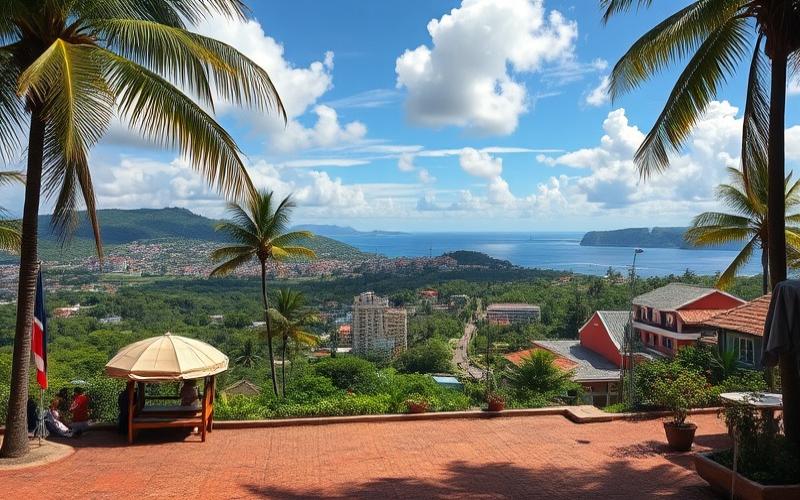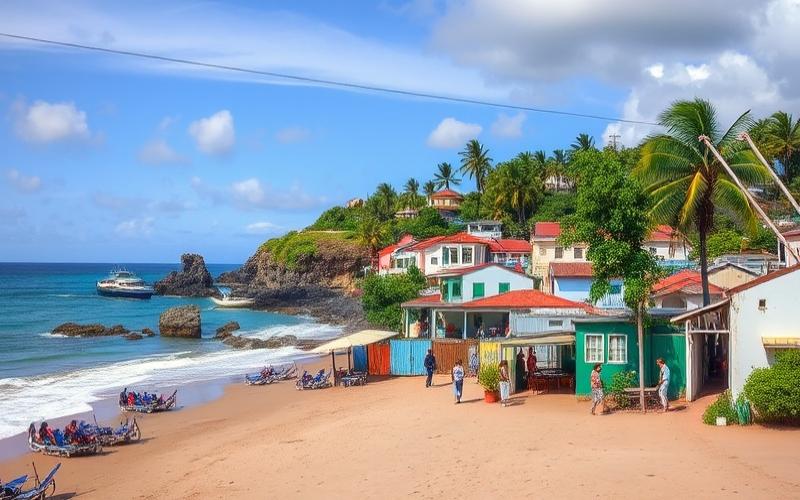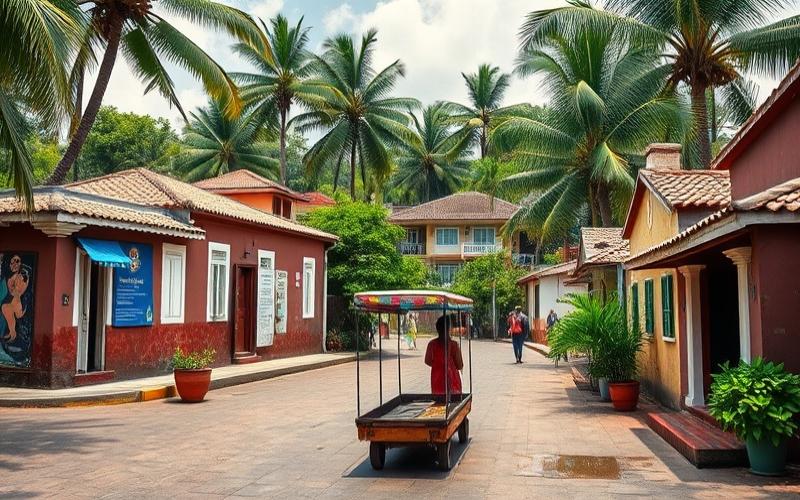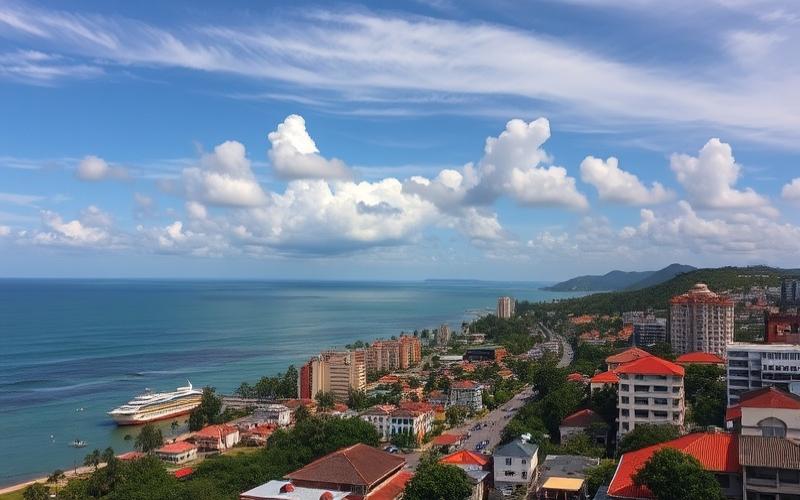
 Published on and written by Cyril Jarnias
Published on and written by Cyril Jarnias
With steady economic growth and an increasing number of local and international students, the Dominican Republic presents fertile ground for investments in student housing. These accommodations, often located near the country’s main universities, offer attractive opportunities for investors seeking to diversify their real estate portfolios.
While the growing demand for quality student housing creates market pressure, rental yields are increasingly catching the attention of savvy investors.
However, to determine whether this investment is truly profitable, it’s essential to carefully analyze the market, taking into account current trends, economic challenges, and the inherent opportunities in this rapidly expanding sector.
The Student Housing Market in the Dominican Republic
The student housing market in the Dominican Republic is experiencing growing momentum, particularly in major university cities like Santo Domingo and Santiago, where demand for student accommodations remains strong.
Market Overview:
- Santo Domingo: As the capital and main academic hub, it hosts the largest universities (UASD, UNIBE, INTEC), generating high demand for student housing.
- Santiago: The second university city with major institutions like PUCMM; local and foreign student populations also stimulate the student real estate sector here.
- Other emerging cities include La Vega and San Pedro de Macorís.
Development Influencing Factors:
- Growth in local and international student numbers, driven by the internationalization of university programs.
- Educational policies promoting access to higher education, including international partnerships or scholarships to attract foreign students.
- Cultural appeal and Caribbean quality of life encouraging off-campus living.
Opportunities for Investors:
- Favorable legal framework: Foreigners can freely purchase real estate nationwide, provided they comply with local laws.
- Acquisition prices generally lower than those in comparable regional markets.
- High rental potential due to the steady flow of students seeking single rooms, shared apartments, or modern private residences.
Challenges Faced:
- Sometimes complex legal regulations for certain types of furnished rentals or shared housing; need for local legal support during transactions.
- Variable returns depending on precise location (proximity to campus/university); potential vacancy during off-academic seasons if supply exceeds demand.
Types of Housing in Demand:
- Independent studios
- Shared apartments (2–4 bedrooms)
- Secure student residences offering additional services (high-speed Wi-Fi, common areas)
Comparative Table — Supply & Demand
| City | Approximate Student Population | Housing Pressure | Average Monthly Rent |
|---|---|---|---|
| Santo Domingo | >200,000 | Very High | $250–450 USD |
| Santiago | ~80,000 | High | $180–350 USD |
| La Vega / Others | Potential for university residence returns | ||
Factors Influencing the Return Potential of University Residences in the Dominican Republic:
- Growing demand for student housing
The continuous increase in enrollments at Dominican universities drives demand for modern, well-located student housing, particularly in Santo Domingo and Santiago. This growth is explained by the rising popularity of certain universities, including among international students. - University cities with high growth potential
– Santo Domingo: Capital and main academic hub (Autonomous University of Santo Domingo, INTEC, UNIBE).
– Santiago de los Caballeros: The country’s second university city, rapidly expanding.
– San Pedro de Macorís: Hosts several campuses and attracts an increasing number of international students.
| City | Number of Major Universities | Enrollment Trend | Growth Potential |
|---|---|---|---|
| Santo Domingo | 10+ | Strong Increase | High |
| Santiago de los Caballeros | 5+ | Sustained Growth | High |
| San Pedro de Macorís | 3+ | Steady Rise | Medium/High |
- Average occupancy rates of residences
Occupancy rates for student housing in Santo Domingo and Santiago typically range between 85% and 95%. This high level is maintained by the lack of quality alternatives and stable demand, especially at the beginning and end of academic semesters. - Comparison of real estate profitability
| Property Type | Annual Rental Yield | Occupancy Volatility | Management |
|---|---|---|---|
| Student Residences | 7% to 10% | Low (stable demand) | Medium |
| Urban Apartments | 5% to 7% | Medium | Low |
| Tourist Properties (Airbnb) | 4% to 8% | High (seasonality) | High |
Key takeaway: University residences offer higher profitability and more stable occupancy than tourist properties, with revenues less subject to seasonality.
- Examples of recent projects and investment return forecasts
– “Campus Residencial Santo Domingo”: Project launched in 2023, achieving 92% occupancy in its first year, with a gross rental yield of 9%.
– “Estudiantes XXI Santiago”: Residence inaugurated in 2024, occupancy rate over 88%, projected net yield of 8.5% over 5 years.
– Forecasts for 2025-2028 anticipate stable demand and a net yield around 8% to 9% annually, assuming macroeconomic stability and consistent university policies. - Legal and tax framework for investment
– Foreign Ownership: No major obstacles for foreign investors; direct acquisition possible after obtaining a residence visa or through a local company.
– Taxation:
– Property Tax (IPI): 1% of value above an exemption threshold (generally for primary residences).
– Rental income taxed at 27% (standard rate for companies/individuals).
– Real estate capital gains taxed upon resale.
– Incentives:
– Occasional tax exemptions for socially or academically oriented projects, especially in public-private partnerships.
– Potential benefits under the CONFOTUR law for projects in tourist or educational development zones, including IPI and profit tax exemptions for several years.
Summary of Key Points for Investors:
- Sharply rising demand, especially in major university cities.
- High occupancy ensuring stable profitability (7-10% annually).
- Accessible tax regime, with incentives for certain strategic projects.
- Recent project examples demonstrating sector dynamism and solid expected investment returns.
The university residence market in the Dominican Republic combines rental stability, growth potential, and a favorable legal framework, making it an attractive asset class compared to traditional or tourist real estate.
Good to Know:
University residences in the Dominican Republic present an attractive return potential, fueled by growing student housing demand following increased university enrollments, particularly in Santo Domingo and Santiago, which are cities with high growth potential. Average occupancy rates often exceed 90%, surpassing those of other real estate types like secondary residences. Recent projects, such as Campus Living and Estudium on the capital’s outskirts, illustrate this momentum with projected investment returns reaching 8% annually over five years. The legal environment also fosters this growth with tax incentives for both local and foreign investors. These advantages position student housing as a competitive investment option compared to other real estate sectors, while addressing a real and growing market need.
Shared housing for Erasmus students in the Dominican Republic offers numerous advantages:
- Reduced cost: Sharing rent and utilities provides affordable housing, significantly cheaper than individual rentals or sometimes traditional university residences.
- Enriching multicultural environment: Living with other international students promotes language practice and cultural openness.
- Dynamic social life: Shared housing encourages friendship building and facilitates local integration.
Availability of shared housing in Dominican university cities
- Major cities like Santo Domingo, Santiago, and Punta Cana offer a wide range of shared housing suitable for students.
- Neighborhoods such as El Millón (Santo Domingo) are particularly popular for their proximity to major universities (UNPHU, UCSD), peaceful atmosphere, and green spaces.
Platforms or agencies facilitating shared housing search
List of recommended platforms:
- Erasmusu
- Roomlala
- Remoters.io
- Facebook Groups (“Erasmus + City Name”)
- Coliving.com
These platforms allow you to:
- Browse targeted listings for students,
- Connect with potential landlords or roommates,
- Check available amenities in the housing.
Tips for securing reliable shared housing and avoiding scams
- Prefer recognized platforms or seek advice from your university’s international office.
- Visit the housing (virtually or in person) before any payment.
- Sign a written contract detailing conditions, duration, deposit amount, and respective responsibilities.
- Research the neighborhood with former Erasmus students (dedicated forums).
- Never transfer money via Western Union or other unsecured methods without guarantees.
Popular neighborhoods for Erasmus students
Indicative list:
- El Millón (Santo Domingo): quiet, near campus
- Gazcue (Santo Domingo): central, lively
- Los Jardines Metropolitanos (Santiago): close to main university hubs
| Criterion | Student Shared Housing | University Residence |
|---|---|---|
| Cost | Low | Variable / sometimes higher |
| Campus Proximity | Often good | Excellent |
| Security | Depends on neighborhood/contract | Enhanced surveillance |
| Social Life | Dynamic/multicultural | Community-based |
| Lease Flexibility | More flexible | Often strict |
In summary
Shared housing represents an economical solution that promotes cultural immersion while offering contractual flexibility; it relies on various reliable digital tools but requires vigilance against scams during the initial search. Student residences, on the other hand, offer optimal security but are limited in capacity and often more expensive.
Good to Know:
For Erasmus students in the Dominican Republic, shared housing offers an attractive economic compromise compared to traditional student residences, which are often more expensive. Living in shared housing not only reduces expenses but also provides a stimulating multicultural environment. In main university cities such as Santo Domingo and Santiago, shared housing is widely available and facilitated by platforms like Student.com or specialized local agencies. Neighborhoods like Gazcue in Santo Domingo or Los Jardines in Santiago are popular for their accessibility and friendly atmosphere. To secure reliable shared housing, it’s advisable to check online reviews and visit the premises before signing a lease to avoid common scams. Compared to student residences, shared housing is often cheaper, with similar campus access and security that may vary depending on the chosen neighborhood.
Disclaimer: The information provided on this website is for informational purposes only and does not constitute financial, legal, or professional advice. We encourage you to consult qualified experts before making any investment, real estate, or expatriation decisions. Although we strive to maintain up-to-date and accurate information, we do not guarantee the completeness, accuracy, or timeliness of the proposed content. As investment and expatriation involve risks, we disclaim any liability for potential losses or damages arising from the use of this site. Your use of this site confirms your acceptance of these terms and your understanding of the associated risks.























































